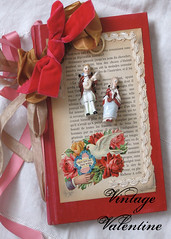
After I made all of those pretty things with leaves, I had to do something with them, didn't I. ;)
Did you notice that my pretty tray ended up on the wall? I think I promised to tell you how to make that! Then, here, goes!

Now the directions, the steps are:
- Press leaves and/or flowers
- Cut glass, mat board, and backboard to size
- Sand and paint frame, and backboard
- Tea stain labels, write labels out
- Drill holes for handles, place handles
- Positioning leaves and labels, affix
- Assembly, including backboard and feet, if desired
My tray is roughly 16 x 18 inches. Any size that you like will do. This was a fire engine red picture frame, with no glass when I found it stashed in that cupboard. So. . . assuming that you, too are using a 'found' frame, first remove the glass, and sand the living daylights out of the wood. This should ensure that the new paint makes a good bond. Spray paint the frame.
Find the center of the short sides of your frame, and measure from that point to drill holes for your handles. Unless you use flat head screws, you will need to counter sink the screw heads on the back side.
Cut (or have cut) a sheet of glass to fit the opening. This is usually very inexpensive at a regular, old fashioned, hardware store, if necessary.
Cut a black sheet of paper/mat board/foam core the size of the opening. I used mat board, but I have a stash.
Cut a piece of Masonite, or other 1/8 inch thick board to fit the back of the frame, approximately 1/2 inch smaller than frame. For instance, 16 x 18 frame = 15 1/2 x 17 1/2 backboard. This will need to be nailed onto the frame, so you will want to drill pilot holes, and use the shortest tack that will do the job. You don't want them to poke through the front of the frame. The pilot holes need only be drilled through the Masonite. You are drilling pilot holes because you don't want to be whacking on the back of the assembled frame with a hammer any more than is absolutely necessary. For my frame, I drilled corner holes, and three others per side.
I am assuming, that you have already pressed your leaves, but if you haven't, scroll down a few posts, and you will find the directions for the method that I used. Artistically position your dried, pressed leaves onto the black (or color of your choice) board, leaving a generous margin and keeping in mind that you will need space for the labels. Glue them in place. I used glue dots, but I'm not certain they were the best idea, maybe spray-adhesive, white glue or 3M quick dry craft glue, definitely not hot glue, because it leaves thick blobs. The glue dots had a tendency to break the fragile leaves.
Labels: If you are lucky enough to get your hands on vintage labels, by all means use them, or color copy them, and use that! I tea stained regular old unlined index cards, then ironed dry and to flatten them.
Tea staining cards: Make a cup/bowl of really strong tea and while it is hot soak the cards in it. Soak as long as it takes to get the color saturation that you are looking for. Five to ten minutes is probably a good estimate. I like to have a little tea standing on the cards when I iron them, it gives them a nice, irregular, somewhat blotchy coloration. You will definitely want to press them on a tea towel. :)
Write out the names, and then cut the card to size. I used a sepia colored marker, but black would work equally well. If you do calligraphy, lucky you! You could print the names on tan card stock, and then trim to size. I just used my best 'scientific' penmanship, because I was hoping for an antique-like, handmade appearance.
Wow! This is a wordy description!
Using a straight-edge, carefully draw a border, or two around each label. This takes a little planning, but if you make a mistake, at least the supplies are inexpensive.
I filled my board with a lot of leaves, so I was a little short on room. Because of that I used only the familiar names of the trees, instead of both the common and botanical, as I had planned, but you can find the proper botanical names easily enough online, after all, you found me! I'm just teasing! I'll help! I liked Backyard Gardener.
Check the spacing for labels on your board by writing out the names on scraps of paper, cutting them to the approximate size, and laying them in place. I was really happy that I went to this effort, it really helped with the space planning.
Glue the labels in place, the pretty ones, not the samples, silly. I used the 3M quick drying craft glue, but glue sticks would probably suffice. Again, I don't recommend hot glue.
Now, you get to assemble it!
- Place the frame face down across an ironing board. Assuming the size works, this is so that the handles hang off of the edges, use any surface appropriately sized for your frame.
- Carefully lay in clean glass, and finished mat board. I added a spot of hot glue in each corner, yes, now hot glue, to hold everything snugly in place.
- Position backboard, being careful that the pilot holes line up with solid wood, and tack in place. If desired, add silicone or felt pads to the corners.
Voila!
Send me a picture, or post it on your blog and send me a link! Debbi
Note: If you choose a frame, like I did, that isn't flat, (can you tell that mine is made from a curved moulding?) it can cause a problem with the handle placement. In mine, the screw that held the handle on wasn't fully obscured. As I see it, you have three options. I chose the easy one, number 3. 1. Carve out space in the frame for the handle to sit squarely. 2. Choose a flat frame. 3. Hide the exposed screw by filling the space with a crafter's clay that is baked to harden. I used black Fimo, and smoothed it out carefully, then baked it for the time recommended on the Fimo package.
To clarify. . . I baked only the frame with handles attached, no glass. I checked with my personal firefighter who assured me that I was baking way below combustion temperature. (which is 400F degrees for wood, I think. . . but he is away at another forest fire, so I can't just ring him up to double check. Wish I could.
One more interesting note: I pretty well battered my poor frame, and needed to repaint it after I had hardened the clay. I did not want to try to mask the handles, but I didn't want to get paint on them either. I coated them with a thin-ish coat of Vaseline (petroleum jelly), spray painted, waited for the paint to dry, and then wiped it off of the handles with a paper towel! Worked like a charm!


















No comments:
Post a Comment